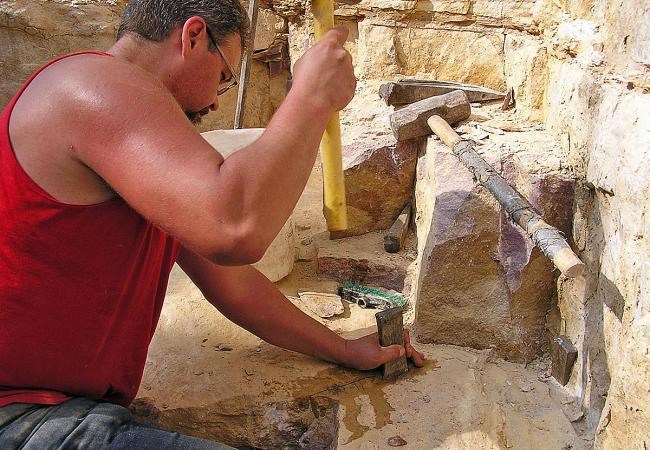Last updated: October 28, 2020
Article
Quarrying: The Unbroken Legacy

NPS/Pipestone National Monument
Many Tribes - Many Traditions
The Iowa and Oto are believed to be the first tribal groups to quarry the pipestone. George Catlin also recorded the Sioux, Mandan, Ponca, and Sauk and Fox peoples as being some of the earliest tribes to quarry the pipestone. By the 1700's, the Yankton Sioux had laid claim to the quarries, but the Sisseton-Wahpeton, Santee, and Flandreau also utilized the quarries. Pipestone was traded extensively throughout most of North America. Eastern Dakota tribes traded pipes with western tribes such as the Tetons at the James River Rendezvous, which occured every year until white intrusion into the area became too powerful.
By the late 1800's, groups of Sioux still came to quarry on a yearly basis. By 1878, pipestone commerce had advanced a great deal. The Flandreau people used pipestone articles for small loans and even boarded trains to sell souvenirs to the passengers. In 1911, the tradition of large groups coming to quarry the pipestone came to an end. Although individual people and smaller groups would continue to quarry the stone even to this day, it was a group of Yankton Elders led by Hollow Horn that became the last large group of Native Americans to visit the quarries and extract the stone.
Early Quarriers
Joe Taylor, a Mdewakanton Sioux, was probably the most active quarrier in the area until around 1933. Taylor, as well as others who would follow him, quarried in small family groups. James Balmer, the superintendent of the nearby Indian school, administered the quarrying operation until 1937 when the National Park Service took over. The number of quarriers declined drastically during WWII. Albert Drysdale, the park custodian, issued the first quarrying permit in 1946 with one major stipulation: any pipestone quarried had to be used for making pipes and other articles associated with Indian folklore. Interest in quarrying remained at a low level into the early 1950's with no more than four permits issued for any given year.
Three local Chippewa and Sioux families - the Bryans, Derbys, and Taylors - kept the craft of pipe-making alive during the 1950's. For the most part, these crafters learned to carve from their ancestors as the skill was passed from generation to generation. Up until the mid-1960's, the pipestone quarries were worked by a small group of men who used the same quarry pits each year. The number of quarriers, however, jumped from ten to twenty-three between 1966 and 1973 as more Native American families from regional reservations began to develop an interest in pipestone.
Today's Quarriers
In recent years, the number of quarrying permits issued by the park has ranged from anywhere between thirty and forty. Most of today's quarriers are from the Dakotas, Minnesota, Wisconsin, Nebraska, and other parts of the central United States, but individuals do sometimes come from farther away.
The best way to learn about quarrying is to observe someone working the stone. A few quarriers work off and on throughout the year, though most quarrying is done in the fall (if observing someone in a quarry, please be respectful and always ask permission before taking a photograph). Between April and October, quarriers demonstrate the craft of pipemaking and carving effigies in the cultural center of the park's visitor center.
Learn more about Pipestone's quarriers.
